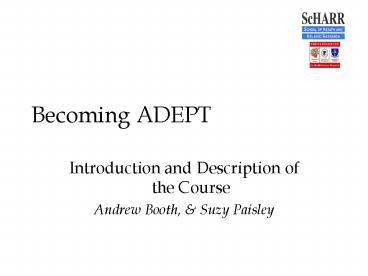Becoming ADEPT - PowerPoint PPT Presentation
1 / 23
Title: Becoming ADEPT
1
Becoming ADEPT
- Introduction and Description of the Course
- Andrew Booth, Suzy Paisley
2
Why ADEPT?
- librarians need to be able to support Evidence
Based Healthcare - users need to be able to do their own focused
searching - only a small proportion (about 1) of the medical
literature is clinically relevant
3
ADEPT - methods
- SEE-ONE, DO-ONE, TEACH-ONE
- Scenarios
- Focused questions
- Small group teaching
- The Group as a resource
- Problem based learning
4
Topics
- Types of question - primary studies
- Diagnosis
- Etiology
- Prognosis
- Therapy
- Types of article - secondary studies
- Reviews
- Economic Evaluations
- Guidelines
5
The Process
- Introduction to study design
- Clinical Scenario
- Focusing the question
- Translating into MeSH terms
- Conducting the literature search
- Applying the methodological filters
- Specialist resources
6
Resources
- About ADEPT
- Becoming ADEPT Project Overview - HLR Dec 1997.
- Becoming ADEPT delivering distance learning on
EBM to Librarians - HLR Sept 1998.
- For each study
- User Guides from JAMA
- ACP Journal Club or EBM MEDLINE Guides
- Institute of Health Sciences Filter page
7
Introduction to Study Design
- Andrew Booth
8
Scenario
- You are a postgraduate medical librarian in
Kleptovale NHS Trust. You have bid for a Nicksnix
Library security system. The postgraduate Dean
wants some evidence that it is effective. There
is no published evidence so you will need to
conduct an original study. What are you going to
do?
9
Answer. A Case-control study
- You call up the Regional Library Unit. Details of
10 libraries with book losses of gt5 (cases) and
of 10 libraries with losses of lt1 (controls). - Phone all 20 libraries and ask Do you use a
library security system? Yes/No
10
You compile a 2 by 2 table.
11
Oh no! Statistics
- Only 40 of libraries with heavy losses had a
security system. - 60 of the controls had a security system
- The Odds Ratio
- Odds of Library with heavy losses A/C 4/6
0.66 - Odds of Library w/o heavy losses B/D 6/4 1.5
- A/C 0.66 0.44
- B/D 1.5
12
But........
- Controls might be underreporting their losses to
make system look good. - People with security systems may be more security
conscious (using other methods) - Bias (flaw in research method) or confounding
(some other factor not taken into account).
13
Case-control studies Retrospective
- Advantages
- Quick and cheap
- Its the only method for rare events
- Requires fewer subjects than other designs
- Disadvantages
- Relies on recall/records
- Open to confounding
- Selection of controls is difficult
- Potential bias in recall or selection.
14
Answer A Cohort Study
- Convince 110 members of HLG to take part in a
prospective cohort study. Over a two year period
you record who uses the system Exposed and who
doesnt Non-Exposed. At end of two years you
calculate rate of heavy losses within both groups.
15
Another 2 by 2 table
16
But.....
- OK so you may have eliminated recall and
reporting bias through baseline data collection,
but - Libraries with security systems may be in richer
areas and less prone to theft anyway.
17
Cohort studies
- Advantages
- Subjects can be matched
- Eligibility criteria can be standardised
- Easier to run than an RCT.
- Disadvantages
- Blinding is difficult
- Randomisation is not present
- Requires a large sample and longer follow up.
18
Answer An RCT
- You go for a sponsored Randomised Controlled
Trial. You recruit another group of HLG members.
You randomly assign half with a free NicksNix
system and the others must go without. After a
year you have the following results.
19
Yet another 2 by 2 table
20
Finally....
- After three years and thirty minutes and three
separate studies the Postgraduate Dean believes
he has the right answer- - No difference, No Nicksnix,
- No comment!!!
21
Randomised Controlled Trials
- Advantages
- Unbiased distribution of confounders
- Blinding more possible
- Randomisation facilitates statistical analysis
- Disadvantages
- Expensive in time and money
- Volunteer bias
- Ethical problems, sometimes
- May create artificial behaviour
22
Postscript
- Practically, you wouldnt go to all that effort.
Maybe use a cross-over design where one Library
(n-of-1 study) or more went through periods
without and then with a system. You would need to
make sure that there was a washout period. Also
you would have to guard against a placebo effect.
23
Hierarchy of research evidence
- Systematic Review
- Randomised Controlled Trial
- Cohort study Prospective
- Case-control Retrospective (May be contemporary
or historical) - Case series
- Individual case study

